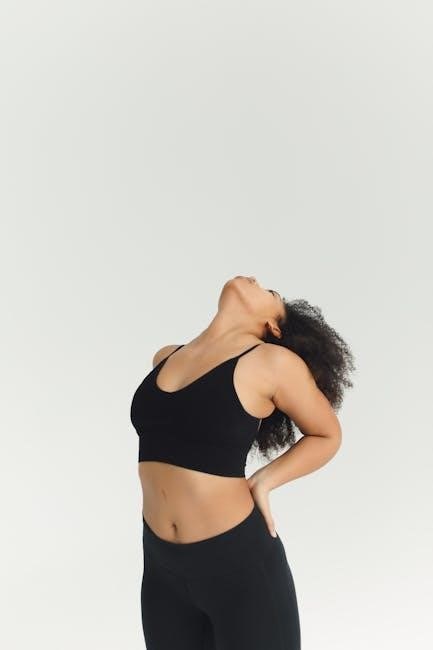quadratus lumborum stretch pdf
Summary
Relieve back pain and improve posture with our Quadratus Lumborum Stretch PDF. Get your step-by-step guide now!

The Quadratus Lumborum (QL) muscle, located in the lower back, plays a crucial role in spinal stability and movement․ Tightness or strain in this muscle can lead to lower back pain, poor posture, and reduced mobility․ Stretching the QL muscle is essential for relieving tension, improving flexibility, and preventing discomfort․ Regular stretching routines, combined with proper posture and strengthening exercises, can significantly enhance overall lower back health and well-being․
Understanding the Quadratus Lumborum Muscle
The Quadratus Lumborum (QL) muscle is a deep, quadrilateral muscle located in the lower back, extending from the 12th rib and transverse processes of the first four lumbar vertebrae to the iliac crest․ It plays a key role in stabilizing the spine, facilitating side bending, and assisting in extension of the lower back․ The QL muscle has two layers: the deep fibers, which are closer to the spine, and the superficial fibers, which are more external․ Tightness or injury to the QL muscle can lead to pain in the lower back, hips, and groin, often referred to as QL pain syndrome․ Proper understanding of its anatomy and function is crucial for effective stretching and strengthening routines to maintain lower back health and prevent discomfort․
Why Stretching the QL Muscle is Essential
Stretching the Quadratus Lumborum (QL) muscle is crucial for maintaining lower back health and overall physical well-being․ The QL muscle, located in the lower back, supports spinal stability and facilitates movements like bending and twisting․ Tightness or strain in this muscle can lead to pain in the lower back, hips, and groin, often referred to as QL pain syndrome․ Stretching helps relieve tension, improves flexibility, and enhances range of motion, reducing the risk of injury during physical activities․ It also promotes proper posture by balancing muscle length, preventing chronic pain and discomfort caused by muscle imbalances․ Additionally, stretching can improve blood flow, aiding in healing and reducing muscle soreness․ Incorporating QL stretches into a routine can enhance spinal stability, making everyday activities easier and less painful, and is most effective when combined with strengthening exercises and proper posture practices․
Common Causes of Quadratus Lumborum Pain
Quadratus Lumborum pain often arises from postural imbalances, overuse during physical activity, or muscle strain․ Poor posture and repetitive movements can lead to tightness and discomfort in the QL muscle․
Postural Imbalances and Their Impact
Postural imbalances, such as an anterior pelvic tilt or scoliosis, can significantly strain the Quadratus Lumborum muscle․ An anterior pelvic tilt shortens the QL, leading to tightness and discomfort․ Scoliosis, involving lateral curvature of the spine, often associates with QL muscle tightness, exacerbating lower back pain․ A lateral pelvic tilt, where one hip sits higher than the other, further imbalances the QL, causing uneven muscle tension․ Poor sleeping habits, like consistently sleeping on one side, can also contribute to QL tightness․ Addressing these postural issues through targeted stretching and strengthening exercises is crucial for alleviating QL-related pain and restoring proper spinal alignment․ Regular attention to posture and muscle balance helps prevent long-term discomfort and promotes overall lower back health;
Overuse or Strain from Physical Activity
Physical activity, particularly when involving repetitive movements or heavy lifting, can lead to overuse or strain of the Quadratus Lumborum muscle․ Activities like cycling, rowing, or bending can exert excessive stress on the QL, causing tightness and pain․ Sharp pains in the lower back, hips, or groin after exercise may indicate QL strain․ Overuse injuries often result from inadequate warm-ups, poor technique, or sudden increases in activity intensity․ Strengthening the QL and improving core stability can help prevent such strains․ Proper stretching and cooling down after workouts are essential for maintaining muscle flexibility and reducing the risk of injury․ Addressing overuse early can prevent chronic pain and ensure continued physical activity without discomfort․

Effective Stretching Techniques for the QL Muscle
Effective QL stretching involves twisting motions and targeted exercises for upper and lower regions, enhancing flexibility and relieving lower back tension․
The Twisting Quadratus Lumborum Stretch
The twisting Quadratus Lumborum stretch is a highly effective exercise for targeting the QL muscle․ It involves a gentle twisting motion that engages the muscle while incorporating surrounding tissues․ To perform this stretch, stand or sit tall, then twist your torso to one side while keeping your hips aligned․ Reach your arms toward the opposite direction to deepen the stretch․ Hold for 30-60 seconds and repeat on the other side․ This stretch enhances spinal mobility, reduces lower back tension, and improves flexibility․ It is particularly beneficial for individuals with tight QL muscles or those experiencing discomfort from poor posture or physical activity․ Consistent practice can lead to better spinal stability and reduced muscle tightness․
Targeted Stretches for Upper and Lower QL

Targeted stretches for the Quadratus Lumborum muscle focus on addressing both the upper and lower sections of the muscle․ For the lower QL, side-bending stretches are effective, where you bend sideways while keeping your arms extended․ For the upper QL, twists that involve rotating the torso while stabilizing the hips can help release tension․ These stretches can be modified to suit different intensity levels, starting with gentle movements and progressing as flexibility improves․ It’s important to hold each stretch for 30-60 seconds to maximize the release of muscle tightness․ Regular practice of these targeted stretches can help alleviate lower back pain, improve posture, and enhance overall mobility․ Consistency is key to maintaining a healthy and flexible QL muscle․

Exercises for Strengthening the QL Muscle
Strengthening the QL muscle involves exercises like pelvic tilts and bird-dog poses, which help stabilize the spine and pelvis, enhancing QL function and overall lower back health․

Core Stability and Balance Exercises
Core stability and balance exercises are fundamental for strengthening the QL muscle․ These exercises improve spinal alignment, reduce muscle imbalances, and enhance overall lower back health․ Bird-dog and side plank exercises target the QL while engaging surrounding muscles․ Single-leg stands and pelvic tilts also help stabilize the pelvis and spine․ By incorporating these routines, individuals can reduce QL tightness, alleviate pain, and improve mobility․ Regular practice strengthens the core, promoting better posture and reducing the risk of injury․ These exercises are essential for maintaining a balanced and healthy lower back, ensuring optimal QL function and long-term pain relief․
Unilateral Exercises for Improved QL Function
Unilateral exercises are highly effective for improving QL function by targeting one side of the body at a time․ These exercises help identify and address muscle imbalances, which are common in QL-related pain․ Bird-dog exercises, where you extend one arm and the opposite leg, are excellent for engaging the QL while promoting spinal stability․ Side planks and single-leg stands also strengthen the QL muscle while enhancing core stability․ By focusing on one side, these exercises can correct imbalances and improve overall lower back health․ Regular practice of unilateral exercises can lead to better posture, reduced pain, and enhanced mobility, making them a crucial part of a comprehensive QL strengthening routine․
Preventing QL Tightness and Pain
Maintaining proper posture and using good body mechanics are foundational․ Regular stretching and strengthening routines, along with listening to your body during activities, help prevent QL tightness and pain effectively․
Proper Posture and Body Mechanics
Maintaining proper posture and body mechanics is essential for preventing Quadratus Lumborum (QL) tightness and pain․ Avoid slouching or leaning to one side, as this can strain the QL muscle․ When sitting, ensure your chair supports your lower back, and keep your feet flat on the floor or a footrest․ Standing with an even weight distribution and avoiding an anterior pelvic tilt can reduce QL tension․ Be mindful of heavy lifting techniques, bending at the knees instead of the waist․ Addressing postural imbalances, such as lateral pelvic tilts or scoliosis, can also alleviate QL discomfort․ Incorporating ergonomic adjustments in your workspace and maintaining awareness of your body position throughout the day are key to long-term prevention․
Regular Stretching and Strengthening Routines
Consistent stretching and strengthening of the Quadratus Lumborum (QL) muscle are vital for maintaining flexibility, reducing tension, and preventing pain․ Incorporate QL stretches into your daily routine, holding each for 30-60 seconds to ensure effectiveness․ Strengthening exercises, such as unilateral movements and core stability workouts, help improve muscle balance and posture․ Regular routines can enhance spinal mobility and reduce the risk of injury․ Start with gentle stretches and gradually progress to more intense exercises․ Combining stretching with strengthening ensures long-term relief and optimal lower back health․ For sustained benefits, practice these routines consistently, ideally 1-2 times daily, and adjust based on your comfort and progress․